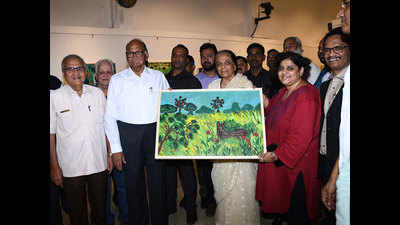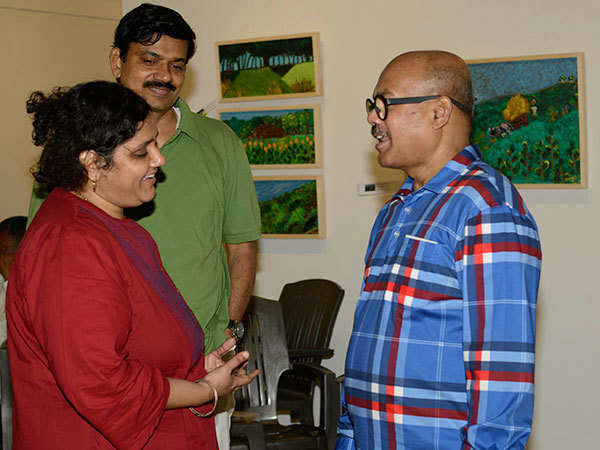- News
- City News
- mumbai News
- Artist-writer showcases lives of women farmers of Konkan
Trending
This story is from February 3, 2020
Artist-writer showcases lives of women farmers of Konkan
‘Aamcho Konkan’ a solo exhibition of paintings by artist and writer Mamta Chitnis Sen that opened recently at Jehangir Art Gallery, showcases the lives of women farmers of Konkan.

‘Aamcho Konkan’ a solo exhibition of paintings by artist and writer Mamta Chitnis Sen that opened recently at Jehangir Art Gallery, showcases the lives of women farmers of Konkan.
‘Aamcho Konkan’ a solo exhibition of paintings by artist and writer Mamta Chitnis Sen that opened recently at Jehangir Art Gallery, showcases the lives of women farmers of Konkan.
Inspired by women farmers and landscapes of Sawantwadi from Sindhudurg region of Konkan, Maharashtra, the exhibition is a display of latest works as well as an amalgamation of paintings created by Mamta over the years. Landscapes from various areas of Sindhudurg too form part of the display.The paintings are an attempt to document the plight of women farmers through art. The works showcase women farmers (of all ages and stages in life—single, married, ageing) attending to their daily chores in life in the fields– either alone or with companions, or in conversations with each other with the lush green fields forming the backdrop for their activity.
With rapid urbanisation, traditional farming over the last few years has been on the backbench in Konkan region which incidentally has also been witnessing migration of farmers from their local villages to nearby cities and town in large numbers. While the men opt for better job prospects, the women who stay behind end up as mere ‘caretakers’ or ‘protectors’ of the lands they once toiled in. Many women unaware on ways of utilizing the lands to their benefit, either abandon them, leaving them deserted and open for encroachments or eventually end up selling them due to family pressure.
“The idea of exploring, documenting and writing about women farmers took shape through a personal experience. A few years ago, I came into inheritance of some ancestral farming land owned from my father’s side. While I was entitled to the land legally through birth right, I soon found myself defending my rights in courts of law mainly because my extensive family members refused to accept the idea. In the following years I fought the matter vehemently through our judiciary system but during those numerous visits to the local court which was based in a remote hamlet in Sawantwadi where the matter was being heard out, I came across several such cases of women being denied inheritance of their own properties. Many hailed from underprivileged backgrounds and were mainly agricultural workers or cultivators. Interestingly while they too toiled equally hard as their husbands, fathers, and brothers, a majority of these women were categorically kept away from being legal heirs on the lands the family owned," she shares.

Art is present in our daily lives in some form or the other. “It is a universal language and representation of relevant and social subjects like the above when portrayed through art, connect well with different audiences,” she signs off.
Inspired by women farmers and landscapes of Sawantwadi from Sindhudurg region of Konkan, Maharashtra, the exhibition is a display of latest works as well as an amalgamation of paintings created by Mamta over the years. Landscapes from various areas of Sindhudurg too form part of the display.The paintings are an attempt to document the plight of women farmers through art. The works showcase women farmers (of all ages and stages in life—single, married, ageing) attending to their daily chores in life in the fields– either alone or with companions, or in conversations with each other with the lush green fields forming the backdrop for their activity.
With rapid urbanisation, traditional farming over the last few years has been on the backbench in Konkan region which incidentally has also been witnessing migration of farmers from their local villages to nearby cities and town in large numbers. While the men opt for better job prospects, the women who stay behind end up as mere ‘caretakers’ or ‘protectors’ of the lands they once toiled in. Many women unaware on ways of utilizing the lands to their benefit, either abandon them, leaving them deserted and open for encroachments or eventually end up selling them due to family pressure.
“The idea of exploring, documenting and writing about women farmers took shape through a personal experience. A few years ago, I came into inheritance of some ancestral farming land owned from my father’s side. While I was entitled to the land legally through birth right, I soon found myself defending my rights in courts of law mainly because my extensive family members refused to accept the idea. In the following years I fought the matter vehemently through our judiciary system but during those numerous visits to the local court which was based in a remote hamlet in Sawantwadi where the matter was being heard out, I came across several such cases of women being denied inheritance of their own properties. Many hailed from underprivileged backgrounds and were mainly agricultural workers or cultivators. Interestingly while they too toiled equally hard as their husbands, fathers, and brothers, a majority of these women were categorically kept away from being legal heirs on the lands the family owned," she shares.
"Even when division of lands happened, the distribution would mainly take place amongst the men in the family. In some rare cases, when few women did get property on their names on paper, in reality, they were refrained from taking decision of their own land. The women ended up merely as caretakers,” says Mamta.

Art is present in our daily lives in some form or the other. “It is a universal language and representation of relevant and social subjects like the above when portrayed through art, connect well with different audiences,” she signs off.
End of Article
FOLLOW US ON SOCIAL MEDIA










